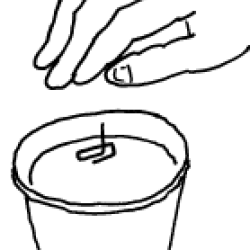Source Institutions
Source Institutions
Add to list Go to activity
Activity link broken? See if it's at the internet archive

In this activity (on pages 29-35), learners examine water pollution and filtration. First, learners build models of water bugs from paper clips, and test the effect of dirt and detergent on their "bugs" floating on the water. Next, learners build a water filter using filter paper, a paper towel, and gravel or sand. The "What We Know" section introduces concepts of how much drinking water is found on Earth, water pollution, the impact of pollution on water quality and surface tension—and how that affects specially adapted species such as water striders.
- 10 to 30 minutes
- 45 to 60 minutes
- $1 - $5 per group of students
- Ages 8 - 14
- Activity, Model, Simulation
- English, Spanish
Quick Guide
Materials List (per group of students)
- tap water
- 3 cups (short, widemouthed, clear plastic)
- 6 small metal paper clips (#1 regular)
- 1 plastic spoon
- 1 tablespoon soil (not potting soil)
- toothpicks
- a drop of liquid detergent
- 1 funnel
- several paper towels
- two #2 coffee filters
- about 3 tablespoons each of gravel and sand
Subjects
-
Earth and Space Science
-
Earth Structure
- Oceans and Water
-
Earth Structure
-
Life Sciences
-
Diversity of Life
- Animals
-
Ecology
- Human Impact
-
Diversity of Life
-
Physical Sciences
-
States of Matter
- Liquids
-
States of Matter
-
The Nature of Science
-
The Scientific Process
- Conducting Investigations
- Gathering Data
-
The Scientific Process
Informal Categories
- Animals
- Nature and Environment
Audience
To use this activity, learners need to:
- see
- read
- touch
Learning styles supported:
- Involves teamwork and communication skills
- Uses STEM to solve real-world problems
- Involves hands-on or lab activities
Designed specifically for
- Rural dweller
Culture, ethnicity, and gender
-
Girls
- Explicity developed for this group
Other
Foreign language versions of this resource:
Components that are part of this resource:
Includes alignment to state and/or national standards:
This resource is part of:
Access Rights:
- Free access
By:
Source Collection
- Science After School Consumer's Guide
Rights:
- All rights reserved, University of Nebraska State Museum and Nebraska 4-H, 2001
Funding Sources:
- National Science Foundation Informal Science Education Program, 9909496
- Howard Hughes Medical Institute
